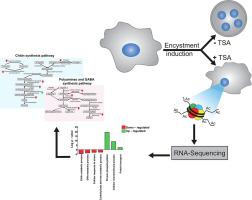International Journal for Parasitology ( IF 3.7 ) Pub Date : 2020-08-18 , DOI: 10.1016/j.ijpara.2020.05.014 Daniela Lozano-Amado 1 , Pedro Antonio Ávila-López 1 , Georgina Hernández-Montes 2 , Paola Briseño-Díaz 1 , Miguel Vargas 1 , Jose-Juan Lopez-Rubio 3 , Julio César Carrero 4 , Rosaura Hernández-Rivas 1

|
Epigenetic mechanisms such as histone acetylation and deacetylation participate in regulation of the genes involved in encystation of Entamoeba invadens. However, the histones and target residues involved, and whether the acetylation and deacetylation of the histones leads to the regulation of gene expression associated with the encystation of this parasite, remain unknown. In this study, we found that E. invadens histone H4 is acetylated in both stages of the parasite and is more highly acetylated during the trophozoite stage than in the cyst. Histone hyperacetylation induced by Trichostatin A negatively affects the encystation of E. invadens, and this inhibition is associated with the downregulation of the expression of genes implicated in the synthesis of chitin, polyamines, gamma-aminobutyric acid pathways and cyst wall proteins, all of which are important in the formation of cysts. Finally, in silico analysis and activity assays suggest that a class I histone deacetylase (EiHDAC3) could be involved in control of the expression of a subset of genes that are important in several pathways during encystation. Therefore, the identification of enzymes that acetylate and/or deacetylate histones that control encystation in E. invadens could be a promising therapeutic target for preventing transmission of other amoebic parasites such as E. histolytica, the causative agent of amoebiasis in humans.
中文翻译:

I 类组蛋白去乙酰化酶与入侵内阿米巴的包囊形成有关。
表观遗传机制如组蛋白乙酰化和去乙酰化参与了参与侵入内阿米巴包囊的基因的调节。然而,所涉及的组蛋白和靶标残基,以及组蛋白的乙酰化和去乙酰化是否导致与该寄生虫的包囊相关的基因表达的调节,仍然未知。在这项研究中,我们发现E. 入侵组蛋白 H4 在寄生虫的两个阶段都被乙酰化,并且在滋养体阶段比在包囊中高度乙酰化。曲古抑菌素 A 诱导的组蛋白高度乙酰化对入侵的大肠杆菌的包囊产生产生负面影响,这种抑制作用与几丁质、多胺、γ-氨基丁酸途径和囊壁蛋白合成中涉及的基因表达下调有关,所有这些都对囊肿的形成很重要。最后,计算机分析和活性测定表明,I 类组蛋白脱乙酰酶 (EiHDAC3) 可能参与控制在包囊形成过程中在几个途径中重要的基因子集的表达。因此,酶和乙酰化/脱乙酰或组蛋白,在控制成囊的标识E. invadens可以是用于防止其它阿米巴寄生虫如的传输有希望的治疗靶标溶组织内阿米巴,阿米巴病的人类病原体。











































 京公网安备 11010802027423号
京公网安备 11010802027423号